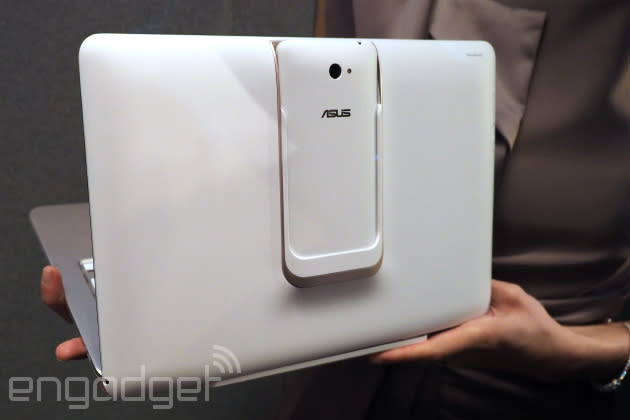Up close with ASUS' quirky Windows laptop/Android phone hybrid

Computex hasn't even officially started, and we're already blown away by ASUS' rather eccentric Transformer Book V from this morning. The name doesn't tell the whole story; it's actually a Windows 8.1 hybrid laptop that lets you dock an Android phone on its back -- a bit like the PadFone concept, except the tablet has its own brain. That's right, you can use both the 12.5-inch tablet and the 5-inch LTE phone simultaneously with their own brains. When docked, you're shown the phone's live Android phone interface within Windows (as pictured above), but you can also toggle the full Android tablet interface. It's easily the most versatile product we've seen of late, but is it practical?
First of all, we should note that the Transformer Book V is apparently still about six months away from market, which may explain why ASUS only had one prototype available for hands-on. The design wasn't even final; it's supposed to look very much like the ZenFone 5. Understandably, the early software didn't perform that well at the time: I couldn't swipe between Android home screens in the windowed mobile interface, for instance. That said, I could launch Android apps just fine in the window, and it didn't take long for the Android mobile interface to pop up in Windows after docking. It's like Motorola's Webtop implementation, but much more powerful. On a similarly positive note, switching between the Android tablet interface and Windows was just a matter of pressing one button on the keyboard.
Since the docked phone is recognized as an external device in Windows here, you'll still have to handle file transfer the usual way via Windows Explorer, rather than through a more seamless experience with some sort of drag-and-drop action over the Android interface (at least for now, anyway). On the bright side, you can transfer files and charge the docked phone without a cable or having the phone lie around the laptop. Another plus is with tethering enabled, you also have yourself an LTE-enabled Windows or Android laptop.

For a tablet of such size, 800g is a pretty nice weight, and this means you're still under 1kg in total when you dock the 140g phone. There was no mention on the weight of the keyboard dock, but I found the full package to be of acceptable weight -- my guess is somewhere just around 1.6kg. This is based on the fact that the slightly larger 13.3-inch Transformer Book T300 has an 800g keyboard dock with a built-in battery, so the Transformer Book V's battery-less dock should be slightly lighter.
Due to the prototype nature of the device we played with, we'll save our hardware comments for a mass production unit. The only complaint we have so far is that the tablet's 1,366 x 768 display is an eyesore for those who are used to much sharper screens; though if -- and it's a big "if" -- this product does take off, there's a good chance that the displays will be upgraded.

Regardless, we think ASUS is at least headed in the right direction: The tablet dock is no longer dependent on the phone. In fact, it's a full-fledged Windows PC on its own, but with the versatility of having Android run in Windows or run natively. But as with many products, this concept's success will ultimately depend on the pricing. We also hope this Windows/Android hardware combo doesn't mean ASUS has given up on the idea of a Windows Phone-powered PadFone.
Hands-on photos by Zach Honig.















